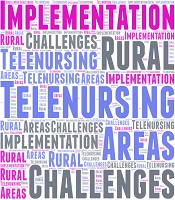Dear Editor,
Telenursing, a new method of providing healthcare in rural regions, holds significant promise for enhancing access to medical services (1). Nonetheless, various challenges in its implementation may affect the quality and accessibility of these services (2). Infrastructure issues represent a major obstacle to the adoption of telenursing in rural regions. Reports indicate that only 72% of rural areas have access to high-speed internet, which can impede effective communication between patients and nurses (3). Additionally, there is a digital divide within the rural population, as only 80% of rural residents own a smartphone, compared to 89% in urban areas (4). Moreover, financial issues arise as rural hospitals experience a drop in revenue when transferring patients to urban facilities that offer telemedicine services (5). Problems with reimbursement and insufficient insurance coverage for telenursing services can also obstruct the growth of these services (6). Lastly, the shortage of specialized personnel and the ongoing need for training nurses to effectively utilize new technologies present further challenges (7). Additionally, cultural and language barriers, along with concerns about data security and patient privacy, further complicate the adoption of telenursing in these areas (8).
Recommendations
To tackle these challenges, the following solutions can be implemented:
- Investment in communication infrastructure: Enhance internet and mobile phone connectivity in rural areas to improve access.
- Providing financial and insurance incentives: Offer financial incentives for healthcare facilities and patients to utilize telehealth, along with ensuring adequate insurance coverage for these services.
- Developing comprehensive laws and regulations: Establish clear and comprehensive laws and regulations governing telehealth practices.
- Conducting educational and awareness programs: Implement educational initiatives for healthcare personnel and the public to raise awareness of the benefits and usage of telehealth.
- Developing support programs for rural areas: Create tailored support programs to facilitate access to telehealth services specifically for rural communities.
